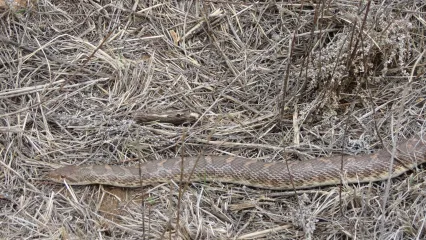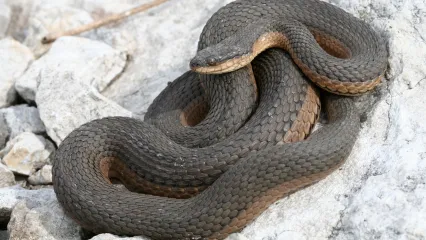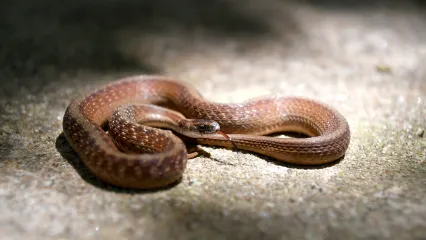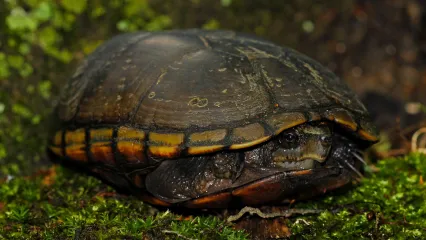
Description
Kansas glossy snakes are moderate-sized snakes with smooth scales that produce almost a glassy effect on the body surface. The background color of the body is cream often with a hint of yellow or orange. The belly is white with no markings. A series of approximately 50 brown or reddish-brown blotches run down the midline of the body. Smaller lateral blotches are also present but often are indistinct in large adults. They are extremely nervous snakes and when held, tend to continually move and typically will not wrap around a person’s hand or arm as do bullsnakes, ratsnakes and kingsnakes. Although Kansas glossy snakes superficially resemble bullsnakes, they can easily be distinguished based on a single characteristic – Kansas glossy snakes have smooth dorsal scales and bullsnakes have keeled dorsal scales.
Size
Adult Kansas glossy snakes vary in size from about 24-40 inches but large adults can reach four and one-half feet. Hatchlings are about 12 inches in total length.
Habitat
The North American distribution of Kansas glossy snakes extends west to east from southwest Texas to central Oklahoma and north to south from east-central Colorado well into Mexico. Other subspecies occur in the western United States.
Life Cycle
Kansas glossy snakes are primarily nocturnal and usually do not become active until it is quite dark. Occasionally they are active during the day when temperatures are high and heavy cloud cover exists. They are usually associated with areas that have sandy, relatively loose soil and they move about at night in a nervous fashion. Mating occurs in early spring and eggs are deposited in late May and June. Females deposit from 2-24 eggs, depending on the size of the female. Hatchlings can be found in late August and September. Kansas glossy snakes eat small mammals, small birds and occasionally lizards. Kansas glossy snakes are harmless to humans.
How To Observe
Because they are nocturnal, Kansas glossy snakes are difficult to observe in the field. They can be found by driving roads after dark but unlike many other nocturnal snakes, Kansas glossy snakes usually will not “bask” on the road but rather move across it rather rapidly. Driving roads at night, particularly in early summer, is most likely to produce results in finding these snakes.
(This profile was created by Dr. Laurie Vitt as part of a partnership between the Wildlife Department and the Sam Noble Oklahoma Museum of Natural History. It was funded as part of a larger grant to survey and inventory amphibians and reptiles of the Wildlife Management Areas of Oklahoma: T-35-P-1.)


